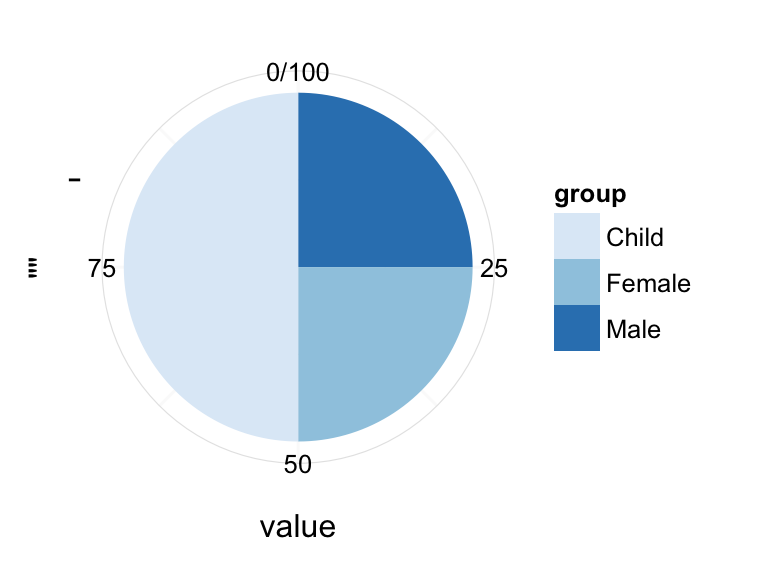

#Ggplot2 pie chart with percentage how to#
In this tutorial, we will explain how to create Pie Chart in R with ggplot2 which is a highly popular and easy-to-use package to create stunning graphs and visualizations in R. Why The Urban Institute Visualizes Data with ggplot2.

3.11 Example 9: Adding Custom Legend Title.3.9 Example 7: Adding Labels to Pie Chart using geom_label() Making use of dplyr you can get the percentage for each type of answer or for each gender.3.8 Example 6: Using RColorBrewer Color Pallete with scale_fill_brewer() Example 1: R library(ggplot2) library(dplyr) count.data 3.7 Example 5: Using Minimal Theme with theme_minimal() Percentage inside the pie chart instead of count.A pie chart showing the percentage share of each sector by consumption. 3.6 Example 4: Applying Gray Scale to Pie Chart using scale_fill_grey() India library(reshape2) library(ggplot2) GCDIndia 3.5 Example 3: Coloring Pie Chart Using scale_fill_manual().3.4 Example 2: Adding Labels to Pie Chart in ggplot2 with geom_text().3.3 Example 1: Basic Pie Chart in ggplot2.3 Examples of Pie Chart in R using ggplot2.Once you have transformed your data, you can pass the column containing the relative. The data set below contains the answers (Yes, No or N/A) of a poll.
#Ggplot2 pie chart with percentage code#
Pie_chart(data, main = "choice", labels = NULL, condition = "dilemma", stat_title = "dilemma x choice") + The following code shows how to create a basic pie chart for a dataset using ggplot2: library (ggplot2) create data frame data <- ame(' category ' c('A', 'B', 'C', 'D'), ' amount ' c(25, 40, 27, 8)) create pie chart ggplot(data, aes (x'', yamount, fillcategory)) + geombar(stat' identity ', width 1 ) + coordpolar(' y ', start. Pie chart with percentages in ggplot2 Data transformation. So I was wondering if the next release of ggplot2 would possibly contain functionality to handle percentages labels for a pie chart.Ĭhoice_pie <- plyr::dlply(fmri_md. A pie chart is essentially a stacked bar chart in polar coordinates. In the programming language R, there are several ways to create pie charts, but one of the most common and powerful ways is using the ggplot2 package. Changing the equation for the position labels ( label_pos = sum(perc) - cumsum(perc) + perc / 2) inevitably messes up one of the conditions. When comparing proportions or percentages, pie charts are a valuable tool for visualizing data. Adding Percentage And Count Labels To The Pie Chart Using ggplot2.

P <- p + labs(subtitle = chi_subtitle(jmv::contTables(df2, rows = 'col1', cols = 'col2', phiCra = TRUE),Īs you can see, it works fine for some conditions, but not for other. P <- p + facet_wrap(condition, labeller = "label_both") # reorder the category factor levels to order the legendĭf] % dplyr::select(condition, main) # if it doesn't work, try toying with the formula for the label_pos to get the desired result value <- 0. # label_pos is a tricky variable to define.the one here will work fine in most, but not all, cases Here’s a video walkthrough with the code used in the video below that. In this recipe, we will learn how to add the percentage values in addition to the names of slices, thus making them more readable. In this article, we are going to see how to create a pie chart with percentage labels using ggplot2 in R Programming Language. # the chi-square test presented.if not entered, the default will be "Chi-square test"ĭplyr::mutate(perc = counts / sum(counts)) %>%ĭplyr::mutate(label_pos = sum(perc) - cumsum(perc) + perc / 2,

# effect is the text label that needs to be entered to denote which interaction effect is being investigated in # custom function to write results from chi-square test into subtitle for the plot


 0 kommentar(er)
0 kommentar(er)
